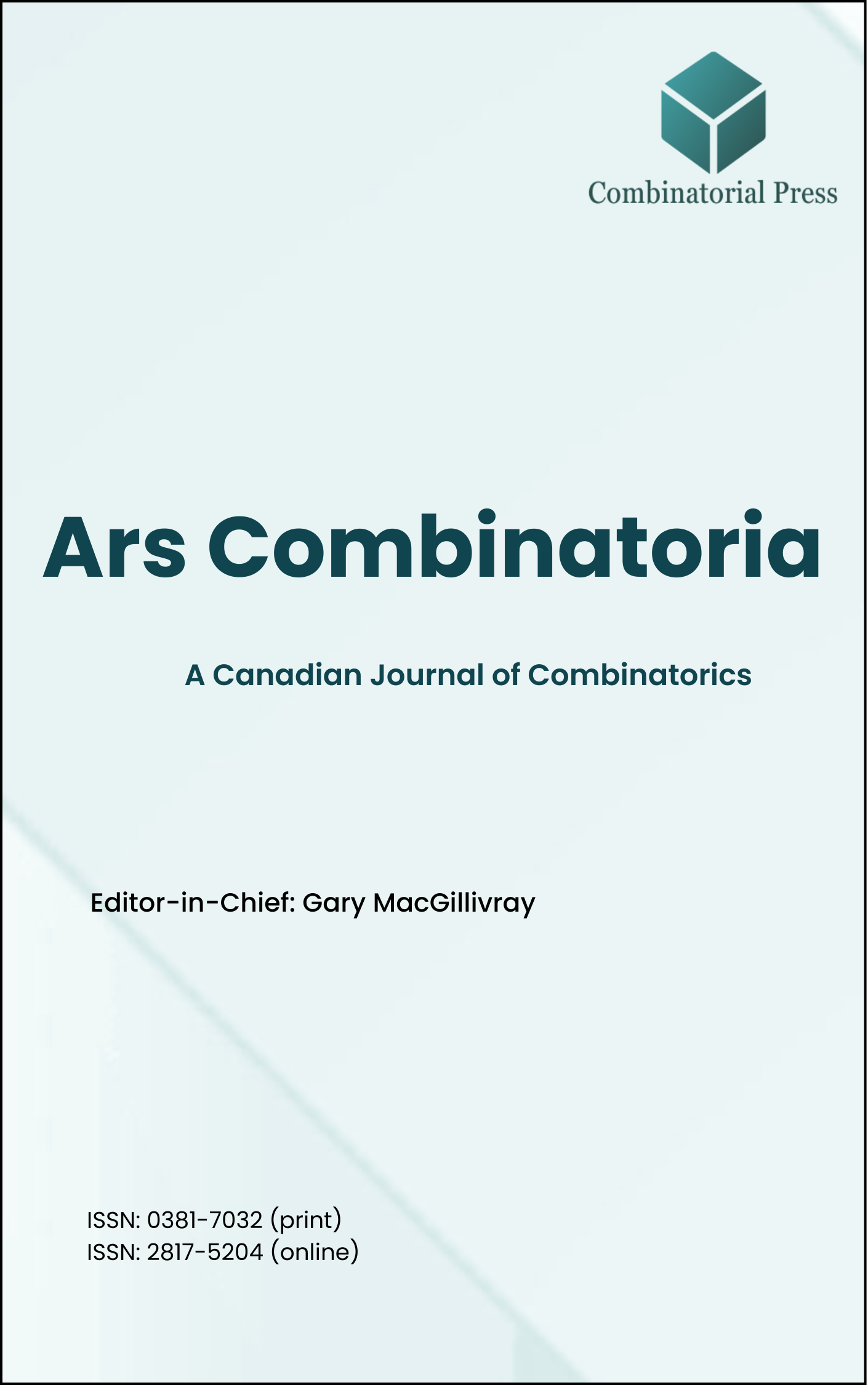
Ars Combinatoria
ISSN 0381-7032 (print), 2817-5204 (online)
Ars Combinatoria is the oldest Canadian Journal of Combinatorics, established in 1976. The journal is dedicated to advancing the field of combinatorial mathematics through the publication of high-quality research papers. From 2024 onward, it publishes four volumes per year in March, June, September and December. Ars Combinatoria has gained recognition and visibility in the academic community and is indexed in renowned databases such as MathSciNet, Zentralblatt, and Scopus. The Scope of the journal includes Graph theory, Design theory, Extremal combinatorics, Enumeration, Algebraic combinatorics, Combinatorial optimization, Ramsey theory, Automorphism groups, Coding theory, Finite geometries, Chemical graph theory but not limited.
Information Menu
- Research article
- Full Text
- Ars Combinatoria
- Volume 029
- Pages: 277-281
- Published: 30/06/1990
The problem of recognizing if a configuration theorem is valid in a given class \(\mathcal{C}\) of incidence structures is equivalent to the problem of deciding, for an arbitrary finite incidence structure \(I\), whether \(I\) is embeddable in some incidence structure in \(\mathcal{C}\).
- Research article
- Full Text
- Ars Combinatoria
- Volume 029
- Pages: 271-276
- Published: 30/06/1990
In a \(\lambda\)-design \(D\), the points \(1, 2, \ldots, n\) are divided into two classes with replications \(r_1\) and \(r_2\), respectively. For any \(1 \leq i, j \leq n\), let \(r_{ij}\) be the number of the blocks containing \(i\) and \(j\). It is proven that \(D\) is type-1 if and only if for any \(i, j\) (\(i \neq j\)) in the same class, \(r_{ij}\) depends only on the class.
- Research article
- Full Text
- Ars Combinatoria
- Volume 029
- Pages: 265-269
- Published: 30/06/1990
Given a graph \(G\) and a positive integer \(k\), a graph \(H\) is a \(k\)-Folkman graph for \(G\) if for any map \(\pi: V(H) \to \{1, \ldots, k\}\), there is an induced subgraph of \(H\) isomorphic to \(G\) on which \(\pi\) is constant. J. Folkman ({SIAM J. Appl. Math.} 18 (1970), pp. 19-24) first showed the existence of such graphs. We provide here a new construction of \(k\)-Folkman graphs for bipartite graphs \(G\) via random hypergraphs. In particular, we show that for any fixed positive integer \(k\), any fixed positive real number \(\epsilon\) and any bipartite graph \(G\), there is a \(k\)-Folkman graph for \(G\) of order \(O(|V(G)|^{3+\epsilon})\) without triangles.
- Research article
- Full Text
- Ars Combinatoria
- Volume 029
- Pages: 259-264
- Published: 30/06/1990
- Research article
- Full Text
- Ars Combinatoria
- Volume 029
- Pages: 193-258
- Published: 30/06/1990
- Research article
- Full Text
- Ars Combinatoria
- Volume 029
- Pages: 187-192
- Published: 30/06/1990
An extension of a method of Hammer, Sarvate and Seberry is given. As a result, from an \( {OD}(s_1,s_2,…s_r)\) of order \(n\) and a \( w(nm, p)\) an \( {OD}(ps_1,ps_2…ps_r)\) of order \(nm(n+k)\) for each integer \(k \geq 0\) is constructed.
- Research article
- Full Text
- Ars Combinatoria
- Volume 029
- Pages: 181-185
- Published: 30/06/1990
It has been conjectured that for any union-closed set \(A\) there exists some element which is contained in at least half the sets in \(A\).
This has recently been shown that this conjecture hold if the smallest set in \(A\) has size one or two, and also to hold if the number of sets in \(A\) is less than eleven.It is shown that the smallest set size approach is unproductive for size three. It is also shown that the conjecture holds for other conditions on the sets in \(A\), and an improved bound is derived: the conjecture holds if the number of sets in \(A\) is less than 19.
- Research article
- Full Text
- Ars Combinatoria
- Volume 029
- Pages: 169-180
- Published: 30/06/1990
Let \(G\) be a graph. A labelling \(f: V(G) \to \{0,1\}\) is called a binary labelling of \(G\). A binary labelling \(f\) of \(G\) induces an edge labelling \(\lambda\) of \(G\) as follows:
\[\lambda(u,v) = |f(u) – f(v)|\] \quad for every edge \(uv \in E(G)\).
Let \(v_f(0)\) and \(v_f(1)\) be the number of vertices of \(G\) labelled with \(0\) and \(1\) under \(f\), and \(e_0(0)\) and \(e_1(1)\) be the number of edges labelled with \(0\) and \(1\) under \(\lambda\), respectively. Then the binary labelling \(f\) of \(G\) is said to be cordial if
\[|v_f(0) – v_f(1)| \leq 1 \quad {and} \quad |e_f(0) – e_f(1)| \leq 1.\]
A graph \(G\) is cordial if it admits a cordial labelling.
In this paper, we shall give a sufficient condition for the Cartesian product \(G \times H\) of two graphs \(G\) and \(H\) to be cordial. The Cartesian product of two cordial graphs of even sizes is then shown to be cordial. We show that the Cartesian products \(P_n \times P_n\) for all \(n \geq 2\) and \(P_n \times C_{4m}\) for all \(m\) and all odd \(n\) are cordial. The Cartesian product of two even trees of equal order such that one of them has a \(2\)-tail is shown to be cordial. We shall also prove that the composition \(C_n[K_2]\) for \(n \geq 4\) is cordial if and only if \(n \not = 2 \pmod{4}\). The cordiality of compositions involving trees, unicyclic graphs, and some other graphs are also investigated.
- Research article
- Full Text
- Ars Combinatoria
- Volume 029
- Pages: 161-167
- Published: 30/06/1990
A \(KS_2(v;1,\lambda)\) is called indecomposable if it is not isomorphic to the direct sum of a \(KS_2(v;1,\lambda_1)\) with a \(KS_2(v ;1,\lambda_2)\) for some \(\lambda_1\) and \(\lambda_2\) which add to \(\lambda\). In this note, we show that there exists an indecomposable \(KS_2(v;1,\lambda)\) for \(v \equiv 0 \pmod{2}\), \(v \geq 4\), and \(\lambda \geq 2\).
- Research article
- Full Text
- Ars Combinatoria
- Volume 029
- Pages: 149-160
- Published: 30/06/1990
A graph \(G\) is said to be \(m\)-neighbour-connected if the neighbour-connectivity of the graph, \(K(G) = m\). A graph \(G\) is said to be critically \(m\)-neighbour-connected if it is \(m\)-neighbour-connected and the removal of the closed neighbourhood of any one vertex yields an \((m-1)\)-neighbour-connected subgraph. In this paper, we give some upper bounds of the minimum size of the critically \(m\)-neighbour-connected graphs of any fixed order \(v\), and show that the number of edges in a minimum critically \(m\)-neighbour-connected graph with order \(v\) (a multiple of \(m\)) is \(\left\lceil\frac{1}{2}mv\right\rceil\).





